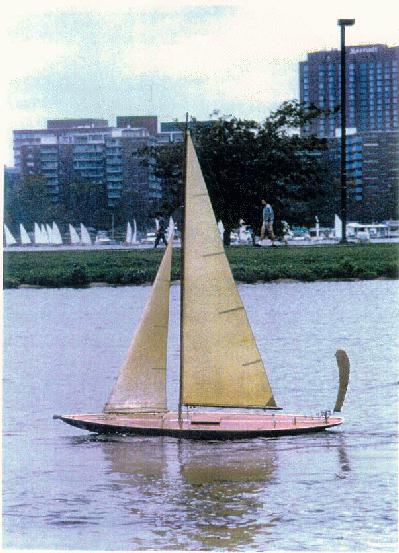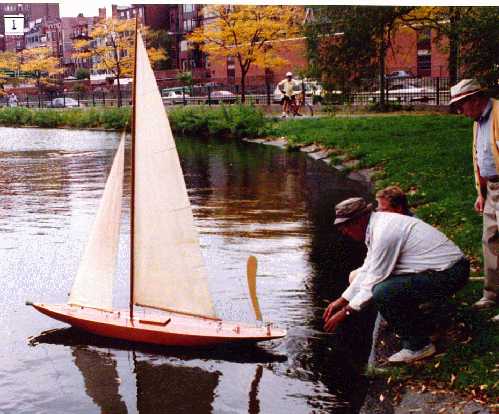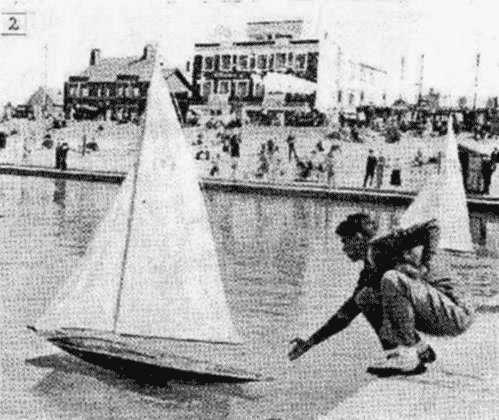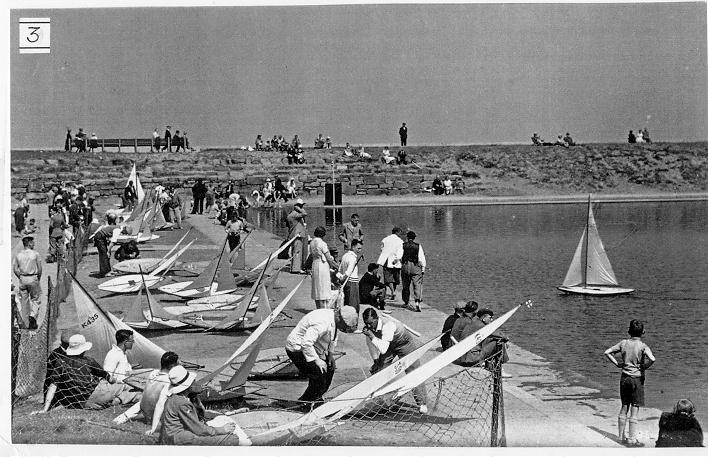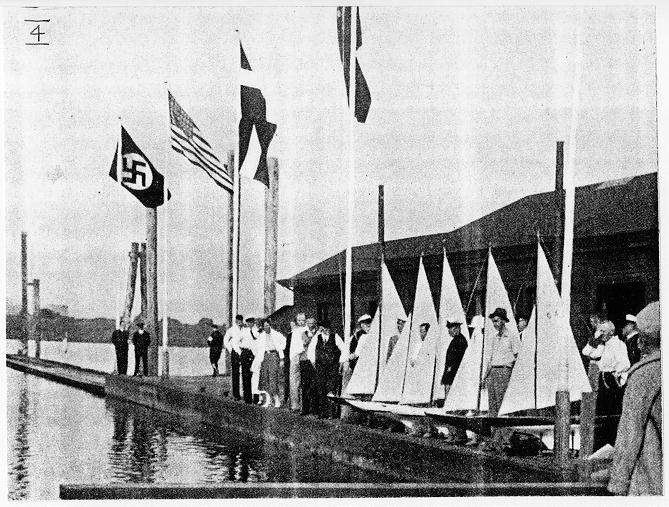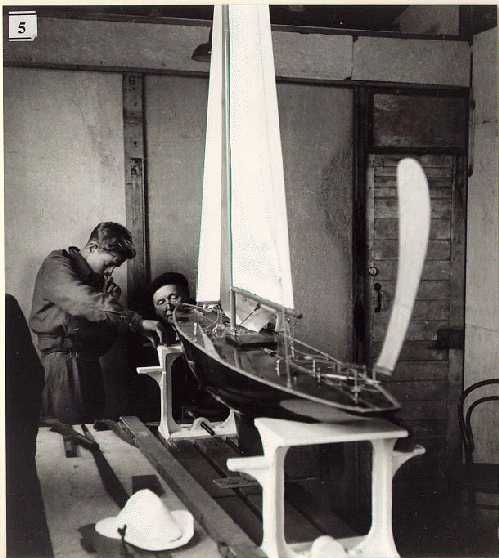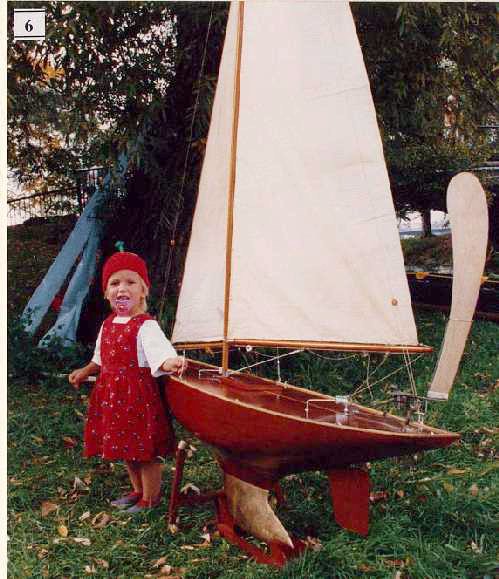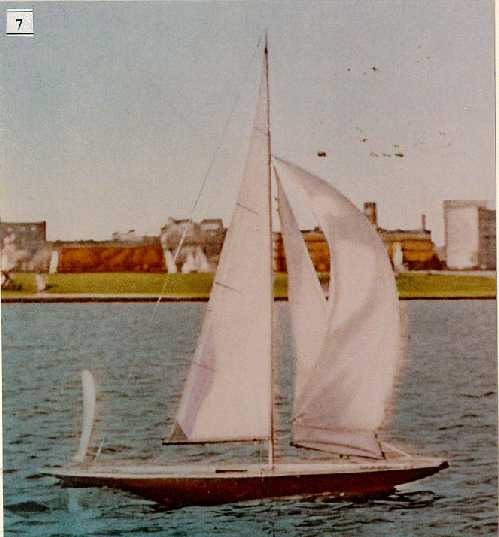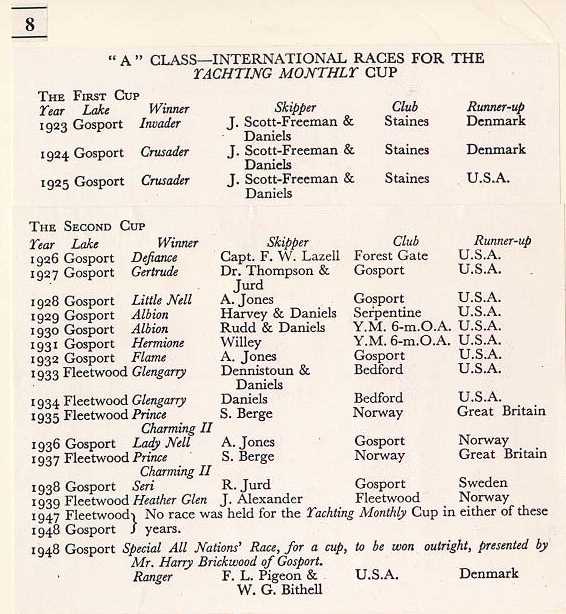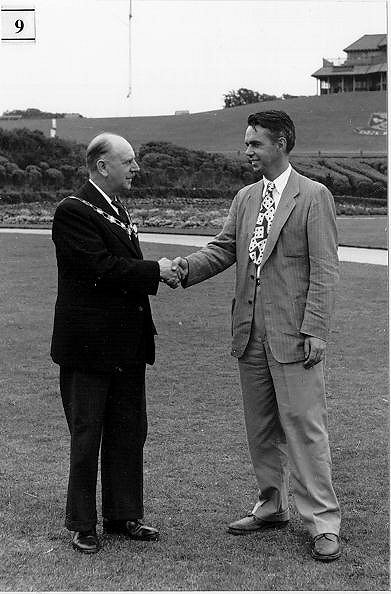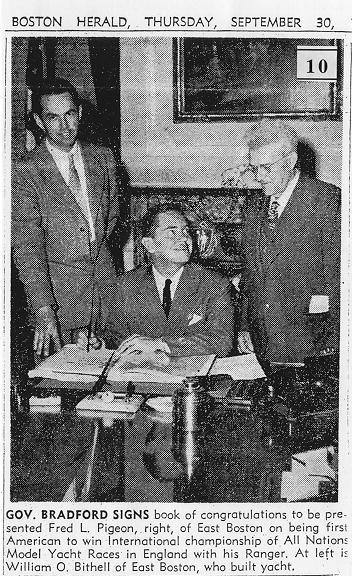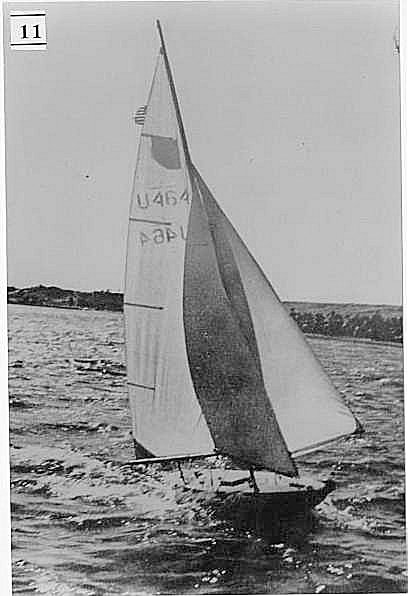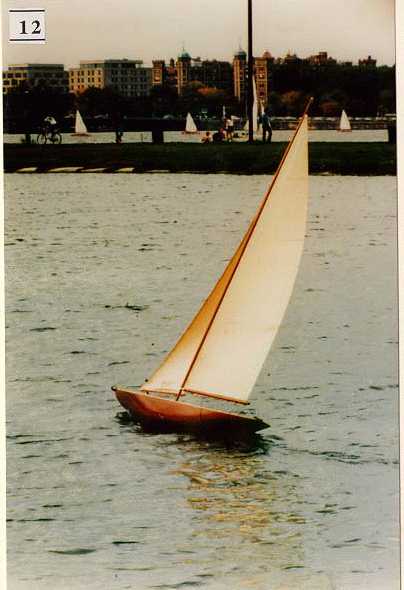Ranger and Bithell Win the Cup for the USA, 1948–1949
by Charley Williamson
After the Second World War, international model yacht racing was resumed, following a period of no racing which extended from 1939 to 1948. Up to this time, USA had never won the Yachting Monthly Cup, which was essentially the World Championships of the model yachting sport. In those days, there was but one World Championships, which was always held following the British Empire A-Class Championships in England, and there did not exist the many different worlds competitions that presently take place for all the various classes. Mr. H.B.Tucker of the British journal Marine Models was even invited to write an article in the American press, in the early 30s, explaining why the Americans had not yet won. Some would point to the fact that Americans favoured skiff sailing, whereby sailors had to be good rowers, since they followed their yachts on open water, whereas the Brits favored almost exclusively the pond sailing. In the latter case, a skipper would set up the rig at pondside, and then he or his mate would meet the yacht at her landfall. In England, it was almost a tradition that a town had to have its pond; indeed, even my sister-in-law’s family had built a pond at Bournville! However, as will be made clear, there existed amongst the Americans some extremely gifted pond sailers. In some articles, John Black, who had represented USA on several occasions, was described as the “Sir Thomas Lipton” of the model yachting world, in that he failed to win the Cup, time after time. According to a later article in Marine Models of 1937, this point was echoed: “a well-known model yachtsman has said that this Cup has caused as much grief to America as the America’s Cup has to England”. The point being made here is that it was a period (1923–1948) when America would dearly have loved to win; it was by far the biggest challenge in model yachting. A win for Bill Bithell and Fred Pigeon in 1948 on British waters would be momentous indeed. This is just what happened.
The origin of the championships goes back to 1921. In that year, W.J.Daniels of England put out a challenge “to any model yachtsman in the United States to meet him in a series of races”. In 1922, a series of races was held off the coast of USA, with the challenger Endeavour of Daniels being beaten by Polka Dot of Ernie Bull. The racing was in skiffs, whereby the sailors chased their yachts and trimmed them on the water. Daniels was inexperienced and lost at least one race through not allowing for the tide, as his yacht sailed off into the distance having passing the wrong side of a buoy!
The return match of 1923, which was raced for the Yachting Monthly Cup in A-Class yachts of around 80 inched in length, took place in England. This was the start of the international races which have continued to this day, reaching a peak of 56 A-Class yachts competing in 1975! From 1923 to 1926, the British, in particular Mr. Bill Daniels, were unbeatable against all comers when sailing on their ponds. However, and this would come as a surprise to those in America who had moaned about inexperience in pond sailing, the British received rude awakenings in 1927 and 1928, when John Black and Jo Weaver (respectively) came over from the States. Both of these matches were extremely close, with the British squeaking ahead by a scant one and two points, respectively. As reported in The Model Yacht of 1928 (a magazine that lasted for but one year in the US), it came down to the last few yards of the very last race to decide the winner; “only a miracle could save Britain from defeat” was written. The miracle came in the form of two wind shifts, or “headers”, that luffed the American yacht, and the English yacht Little Nell crossed the line six inches ahead of Patsy. At that time, it was reported to be the most “spectacular finish to an international Race that has ever been seen”. The Brits had woken up to the danger of defeat, which was hitherto deemed unthinkable.
Between 1929 and 1934, Daniels steered four further yachts to victory in the international races, but 1935 was to see, for the first time, a new country at the front. Sam Berge of Norway entered the races, using a new “vane steering gear” to keep the yacht at a preset angle to the wind, and he won the Championships. The vane gear, with which Herreshoff had experimented decades earlier, was thus used for the first time in a major regatta, and its success led to gradual adoption, until it was almost universally used after the War. Self-tacking vanes were later to be used, with ever more complexity, until the 1970s. This international regatta of 1935 also saw Bill Bithell competing, for the first time, with Yankee II. Let us digress for a moment.
In Fig. 1, taken in August 1995 at Storrow’s Lagoon in Boston, the site of many early American championships, we can see the same Bill Bithell casting off his mahogany-planked A-Class yacht Ranger III, completed over the winter of 1994–5, at the age of “eighty something”. He is watched by several other vintage yacht sailors (or one should say “sailors of vintage yachts”) of the US Vintage Model Yacht Group, affiliated with the AMYA.
We shall later realize the significance of this particularly beautiful, and recently constructed, yacht, but for now we can note the similarity of Bill’s stance at the pondside in 1995 with the style he had 60 years earlier in 1935 (Fig. 2), as a young, indeed “pukkah”, Bill, pushing off his Yankee II at Fleetwood! It was reported in Marine Models: “Yankee II is a pretty yacht but appears too lean forward and was unbalanced”. However, the real problem in the 1935 races was caused by the Englishman Colonel Holden tacking his yacht into Yankee II early in the regatta, breaking her mast, and upsetting the American yacht’s delicate balance. Bithell finished fifth behind Norway, Britain, France, and Germany, but he had begun his quest to bring the Cup to America.
Chapter 2
Bill Bithell went on to take the National A-Class championships again in 1936 at Detroit, with Blue Chip, and so to earn for him a second challenge for the YM Cup in England. Although the challenger fleet was typically less than a dozen, it comprised some of the country’s best sailors such as John Black, Archie Arroll, Steinbrecker, and Charley Farley. On the other hand, the British Empire championships, which would choose the yacht to race the foreign entrants, was typically chosen from around 30 boats.
A view of Fleetwood in 1935, giving a flavor of the atmosphere of the regattas, is seen in Fig. 3, showing some of the large fleet of yachts on the grass, resting between their match racing, or what were known as “boards”. One should note that yachts of that era were typically planked, and gloriously pretty, with cotton sails, a far cry from modern yachts. Often the top competitors wore sailors’ or captains’ caps, and “whites”: the kind of smart clothes worn by 1930s tennis or cricket players, a far cry from modern dress.
1936 was a big year. Germany was busy putting on a world show with the Olympics, and model yachting was to be an Olympic Demonstration sport based at Hamburg in August. Bill was selected to skipper, with John Black as mate in both the Olympics and in the YM Cup, and he was selected to mate for Black at the Olympic Marblehead competition. Despite bursts of speed in Hamburg, Bithell finished 3rd behind two British yachts, including the Colonel Holden, although Black won the Marblehead event with Bithell as mate. We can see the competitors lined up with their yachts on a pontoon, in Fig. 4. Bill Bithell is the tall chap in the hat. Bithell recounts this adventure in Germany, stating with a smile that the trip was “all on Adolf”. They were invited to watch the Star yachts (of the large variety) compete for medals at the Kiel Olympics and to partake of tea with Oberstlieutenant Kewisch and the Duke and Duchess von Holstein at Kaiserliche Yacht Club. Heady days!
The YM Cup races were held at Gosport, and the handsome Blue Chip was described as having “tremendous speed through the water, particularly in light airs”. She sailed superbly for 2 days, just behind the leader Lady Nell of the British Empire, but did not fare well on the final day to finish 4th behind Britain, Norway (Berge again), and France. Nevertheless, Blue Chip was incredibly fast off the wind, winning the “Wing-and Wing” Cup for the fastest run down the lake. One should not forget that spinnakers were used in those days, and there was great skill in trimming the yachts for downwind sailing. At the closing ceremony, the Lord Mayor of Gosport stated that where the Geneva peace talks had failed to bring about security and peace in Europe, the sports of the Olympiad, and the model yachting of course, would bring nations together. There was talk of model yachting entering as a full sport in the Olympics for 1940, but little did they know then that the Second War was to put a halt to all these activities. In fact, Bithell was not to return to England until after the War. In 1937, he was informed by the Model Yacht Racing Association of America (MYRAA) that the same American could not compete in a YM Cup three times in a row, for essentially arbitrary reasons. He had a particularly fast boat at this time, namely Redskin which had trounced the other 18 competitors at the Eastern Division Eliminations races, all of whom read as a “Who’s Who” of American model yachting at the time. A plan to go anyway, with Bill Mansfield as the ostensible skipper, was foiled by the Port Washington Finals. They lasted for 15 exhausting days in ultra-light weather and never finished before the last ship that would have gotten them to England in time for the Cup had set sail into the Atlantic. The 1937 World championship was won, for the second time, by Sam Berge of Norway, just pipping the British boat, who herself had beaten 28 other yachts to qualify. In 1938, MYRAA decided not to send anyone across to England. Again, Bithell had won the National Championships. The YM Cup in 1938 saw the British Seri of Ron Jurd win. The English Alexander family from Lancashire (with whom I had tea earlier this Summer 1995), won the YM Cup very easily with Heather Glen in 1939 in a fleet of six nations. They had been “knocking at the door” for the Cup for many years. This family had made class racing yachts and toy yachts of exceedingly top quality and beauty, which are now perhaps the most sought after vintage yachts in England, almost to rival Bill Bithell’s yachts in their beauty.
Traveling to regattas in those days was done by car. A journey across country was highly exhausting, as it entailed driving those old heavy cars across the continent and back. Bill Bithell did this in a 4-door 1936 Ford in 1939, with the A-Class Venture strapped to the roof, to defend the National Championships he won in 1938. He and the accomplished designer Harry Richardson, on their way from Boston to Berkeley, stopped by the house of C.O. Brook, one of the top officials in MYRAA. According to Brook, “somewhere between Canada and Detroit, while attempting to pass a hay truck (at high speed I’ll bet) they left the road, turned over and demolished the car without damaging the boat (except spars). This left Richardson with a broken wrist, two stitches in his scalp, and eight in his ear, and they still continued on to the races, after a week of delay waiting for repairs.” In fact, the delay prevented Bithell from taking advantage of the vane gears which were being installed on competitors’ yachts that had arrived early. Eight of the ten yachts had vanes, and proved too much of an advantage, leaving Bithell only fourth. “I would have cleaned up had I had one of the vanes”, he said, and from that point on almost no one continued to use the Braine gears (introduced in 1904) to steer their yachts.
At the end of the Regatta-edition of Marine Models for September 1939, there is a single paragraph which states in a most poignant manner: “For reasons that do not need any explanation, we have decided to suspend publication after this issue”. The journal itself was never to return in its original form, although international racing was to resume in 1948, a year which had great significance to Boston and to United States sailing.
Chapter 3
In 1947, Bill Bithell built a yacht, commissioned for major races by Fred Pigeon, to the design of Alberg. In Bill’s own words: “It was out of balance … I told Pigeon it was a dud. He was P.O. and next week he had Alberg at the pond. He agreed and said he would correct the design.” The new 84-in design became the classic yacht Ranger. Bithell and Pigeon set forth on the Cunard liner Mauretania across the Atlantic to challenge the British. The result is history. They convincingly won the international “All Nations Cup”, in superb form. For obscure reasons, this Cup had been substituted for this one year in place of the YM Cup.
In Fig. 5, we see the gleaming-varnished Ranger being measured up before the races, and may be compared with the recently-completed Ranger III in Fig. 6.
It is clear that the large crowds (as existed in those days at such events) cheered long and hard when Ranger won the race against Denmark that clinched the title. One of Ranger’s fastest points of sailing was on the runs, and she is seen flying downwind with spinaker in Fig. 7, in England.
When they sailed a final race against Belgium, Ranger won from behind in the final few yards, and “the crowd went ‘haywire'”. It is really best for us to read the words actually written in Model Yachting of October 1949 by Fred Pigeon himself, to share some of the atmosphere of the last race that finally gave USA the Cup, as follows:
Now came the most important—the most crucial race of the day. We asked ourselves, ‘Will the Ranger continue her previous wonderful performances?’
Denmark was to windward but windward or leeward Ranger seemed to sense her responsibility. When we came ashore 200 feet from the starting line we had worked into the windward position. Denmark decided to use the guy. Bill had slipped our guy at the start as the wind was up and down the pool and a fine breeze blowing. The Ranger sailed straight down the pool. When she came over to me I tacked her and she was away. The run down was another beautiful sight with the spinnaker billowing out as she crossed the line, not only the winner of the particular race but the winner of the All Nations Cup. We received a big and sincere ovation as all the spectators extended their congratulations to bBill and me. Our next and last opponent was Belgium. Although we had won the cup we were obliged to sail this race. Belgium had the windward position but this did not worry the Ranger. She was soon out in front and our score was increased by 3 points. The run home was the most spectacular race I have ever witnessed. Belgium worked out a lead of 100 feet and kept that lead halfway down the pool. Then Ranger seemed to realize her position and started after her opponent, gaining slowly. Ten feet from the finish line she overlapped the Belgium boat and then Ranger took a leap forward as if a supernatural hand gave her a tremendous pull and she came across the line a winner by inches. The crowd went “haywire.” It will be a long time, if ever, before such a finish will be seen again.
All the officials in their congratulatory remarks stated that they had never before seen such a performance at any model yacht race.
At this point, I wish to pay sincere tribute to Bill Bithell for his expert handling of Ranger and for his many thoughtful courtesies in my behalf throughout the races. We were indeed a very happy pair of Model Yachtsmen, for we had achieved what many from the U.S.A. had attempted over a long period of years. People gathered around the Ranger expressing their admiration, taking pictures and measurements, and wishing us all kinds of success in the future. The Mayor of Gosport presented the cup surrounded by the flags of the nations represented.
Bill Bithell and Fred Pigeon received much fanfare after the win. At Fleetwood he can be seen, in Fig. 9, shaking the hands of the Lord Mayor of that town! Back in America, he was to meet, with Pigeon, Governor Bradford at an official ceremony, shown in Fig. 10.
We depart from Fleetwood with one last look at Ranger as she speeds off the wind in Fig. 11 in a famous published 1948 picture.
She is reflected in Fig. 12, by her new sister of 1995, who is charging along on the wind. In 1949, Bill Bithell and Ains Ballantyne clinched the Yachting Monthly Cup at Fleetwood, England. The cup was raced for in the US subsequently and then returned to England where it is still raced for each Summer by about 20 A-Class yachts, which are vane-steered. However, when Bill Bithell won the cup in 1948 and 1949, it closed out a chapter in international model yachting.
Bill himself had been racing since 1932, and had attended MIT. As a talented engineer, he remains acutely aware of the design, construction and importantly, the “balance” of a yacht, which seemed more essential in the old days, when one could not simply overide an off-balance yacht with R/C rudder action. Bill Bithell has made many yachts and sold sails and fittings of the very best quality for decades. He remains a disarmingly humble, humorous, yet exceedingly accomplished man, and is, above all, one very nice person. He was the one who skippered the first American yacht ever to beat the British for the World championship after a struggle of 25 years. As for the original Ranger, she is sadly neglected, as are many class racing yachts, in the back of a museum stockroom.
In conclusion, and to bring us up to the present, Bill Bithell has built a Ranger III over the last winter (1994-5). The building of this yacht has been patiently awaited by a great many people, not the least by certain members of the US Vintage Model Yacht Group, affiliated with AMYA. The result is beyond our expectations as a work of art. The combination of African mahogany, with the cotton sails, and chrome fittings, all built in the manner which Bill Bithell has used for decades, and at the same time conforming painstakingly with the A-Class rule, is truly exquisite. This kind of beauty, in both model and full-size yachts, is a thing of the past.

